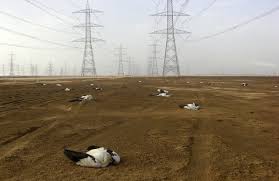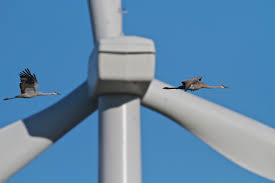A new study published by the U.S. Geological Survey finds that sandhill Cranes flying over the Great Plains are not at serious risk from the many wind turbines in the region. It said the current placement of the towers in central and southern Great Plains, a region that includes Oklahoma, Kansas and Texas “may have relatively few negative effects on sandhill cranes wintering in the region.”
Scientists with the USGS compared crane location data from the winters of 1998-2007 with current wind tower sites in Texas, Oklahoma, Kansas and New Mexico prairies. Findings showed only a seven percent overlap between cranes and towers, and that most towers have been placed in areas not often used by cranes during the winter.
“Great Plains wetlands are critical to preserving valuable sandhill crane populations,” said USGS scientist Aaron Pearse, the study’s lead author. “Our findings can help managers minimize risks of future wind energy development to cranes by highlighting potentially hazardous locations.
Using data from cranes tagged with satellite transmitters, the scientists estimated wintering crane distributions and habitat selection behaviors prior to and during wind tower construction which began in 1999 but surged from 2004-2013. They then compared the early estimates with post-construction bird behaviors and current tower locations.
Scientists found that when the sandhill cranes spent time near wind towers in the Texas High Plains, the wintering birds maintained an average distance of 6.5 kilometers or about four miles from the towers. Only about five percent of the towers in the Texas High Plains have been built in locations identified as highly preferred crane winter habitat.
Eighty percent of the midcontinent sandhill crane population resides in the central and southern Great Plains for up to half of the year.








